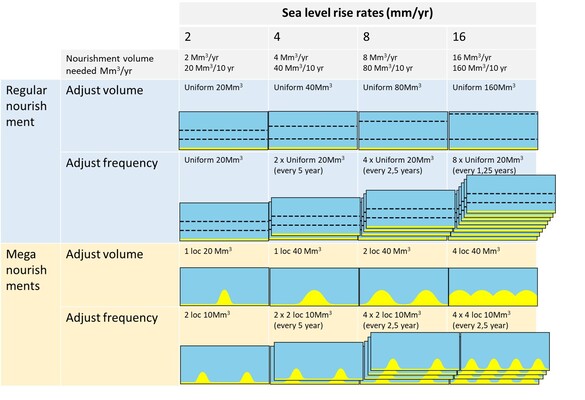J. Rutten1*, R.C. De Winter1 , M. Haasnoot1,2
1 Deltares, The Netherlands; 2 Utrecht University, The Netherlands
* Corresponding author: jantien.rutten@deltares.nl
Introduction
A large part of the Dutch beaches suffers from erosional losses that will result in shoreline retreat without the compensating sand nourishments that are now currently placed on a regular basis. Currently, the total annual nourishment volume is linked to observed sea-level rise rate (Lodder and Slinger, 2022). Projected increase in sea-level rise rate is thus expected to demand larger nourishment volume (Haasnoot et al., 2018; Van Alphen et al., 2022). Different strategies exist to upscale nourishment volume, including more frequent placement of nourishments with regular volume and infrequent placement of large nourishments (e.g. Zandmotor, Hondbossche Duinen).
The coastal zone provides a multitude of ecosystem services. Nourishment strategy can differently affect these services. Therefore, integrated assessment of the key functions is demanded to highlight under which conditions these functions can be guaranteed and how they evolve with time.
Objective and Methods
Our aim is to demonstrate how three key functions (flood safety, a functional ecosystem, recreation) of the Dutch coast are affected by different nourishment strategies under increasing rates of SLR, and explore the potential multi-objective adaptation pathways.
Following the Dynamic Adaptive Policy Pathways (DAPP) approach (Haasnoot et al., 2013), we linked indicators to the objectives and define a solution space of adaptive measures and changing conditions. Here, we applied the DAPP approach three times, providing pathways for each objective. Based on scientific literature, technical reports, expert judgement and stakeholder input, indicators were evaluated over a 10 year timeframe for each adaptive measure.
The following indicators were selected: (i) dune volume for flood safety, (ii) benthic species richness and diversity for a functional coastal ecosystem, and (iii) beach width and swimmer safety for recreation.
The solution space, wherein the nourishment volume budget scales with the rate of SLR in 2100, contained two shoreface nourishment and two mega-nourishment strategies for four SLR scenarios (16 strategies in total; Fig. 1). Strategies were designed for a 20-km long straight coast, uninterrupted by harbour jetties and with wind-blown dunes, inspired by the Delfland coast.
Results
Evaluation of the indicators reveals that many strategies score adequate for most objectives, and thus several strategies remain an option for increasing rates of SLR. Dune volume is not assumed to decrease given that dune erosion volumes were predicted to not notably increase under SLR if nourishments were placed with volumes that scale with SLR (De Winter and Ruessink, 2017). Note that specific mega-nourishment strategies remain difficult to evaluate as currently no future projections exist on dune growth at beaches far but under influence of the mega-nourishment. Benthic species richness and diversity directly after nourishment are assumed to be inadequate due to the thick layer of nourished sand leading to suffocation. Full recovery of benthic fauna was observed to take several years (Van Dalfsen and Essink, 1997), and thus strategies with frequent intervention are not preferred for the functional ecosystem objective. Beach width and swimmer safety are not largely affected by shoreface nourishments, and thus recreation is evaluated as adequate up to 10 years after the first intervention. Local 500-1000m increase in beach width due to mega-nourishments can hamper the recreation objective. Corresponding adaptive pathways will be shown at the conference, revealing which strategies support multiple objectives.

Solution space of sandy strategies in 2100 with schematics showing top view of coast wherein shoreface nourishments (dashed lines) and mega-nourishments (yellow areas) are indicated.
References
De Winter and Ruessink, 2017. Sensitivity analysis of climate change impacts on dune erosion: case study for the Dutch Holland coast. Climatic Change, 141(4), 685-701.
Haasnoot et al., 2013. Dynamic adaptive policy pathways: a method for crafting robust decisions for a deeply uncertain world. Global Environmental Change, 23(2), 485-498.
Haasnoot et al. Mogelijke gevolgen van versnelde zeespiegelstijging voor het Deltaprogramma: een verkenning. Deltares, Delft, The Netherlands, 2018.
Lodder and Slinger, 2022. The ‘Research for Policy’ cycle in Dutch coastal flood risk management: The Coastal Genesis 2 research programme. Ocean & Coastal Management, 219: 106066.
Van Alphen et al., 2022. Uncertain accelerated sea level rise, potential consequences, and adaptive strategies in the Netherlands. Water, 14, 1527.
Van Dalfsen and Essink. Risk analysis of coastal nourishment techniques (RIACON). Rijksinstituut voor Kust en Zee, The Netherlands, 1997.










